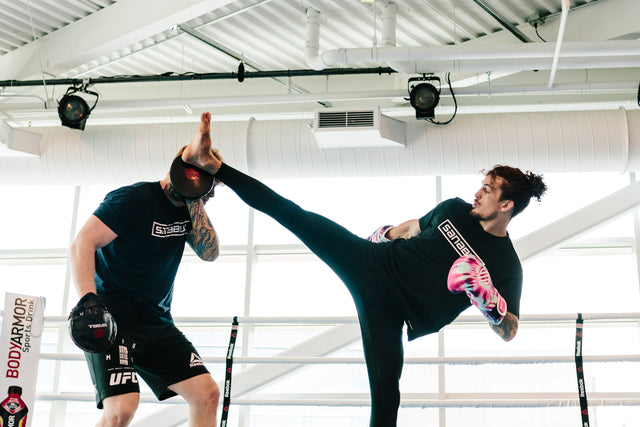Basic Striking: Front, Round, and Side Kicks
When it comes to striking in combat sports, there are a variety of strikes that a fighter can have in their arsenal. Punches, kicks, elbows, knees are the most commonly used strikes due to their effectiveness. This article will examine kicking.
Here are three types of kicks that practitioners will learn in training:
- Front kick
Teep
Push kick
- Roundhouse kick
- Side kick
These kicks are very versatile and can be thrown by both the lead and rear leg.
Front Kicks
The front kick is used for two main purposes: pushing back and stabbing into an opponent. There are different variations of the front kick that are as follows:
Teep
The teep kick is a lead leg front kick. To throw it, the lead leg in a fighter’s stance will be raised in a chamber position. The knee is brought up to anywhere from hip to chest level. From here, balance on your back leg and thrust your hip (on the kicking leg side) forward toward the target, while your upper body leans back. As this happens, swing your lead arm back (leg goes forward, arm goes back) and push the lower part of the kicking leg (everything below the knee) into the target. Aim to connect with the ball of the foot. When pushing the kick, pivot your back foot so that the inside part of the foot is facing the target - this will help generate more power by giving a little extra push to the hip. After throwing the teep kick, the leg will either re-chamber and land around the same place it started from or land in the area where the motion of the kick ends (advancing the fighter forward). Either way, the fighter will return to their fighting stance after throwing this kick.
When to use: The teep is a great kick to push opponents back and keep distance between two fighters. It can also be used to stab into an opponent’s body, if the ball of the foot is jammed into their midsection and the toes are pointed outward. Depending on if the teep is used to push an opponent back or be jammed into an opponent’s body/face, the speed of this kick will vary. When using the teep to push opponents back, the teep can be thrown anywhere from a slow to a fast speed (as long as it pushes the opponent back). For the purpose of thrusting the foot into the opponent’s body, the teep will usually come at a higher speed. The teep can be thrown and landed in a very short amount of time, making it a formidable option for both managing distance and doing damage.
Push Kick
The push kick is a front kick thrown by the back leg. When throwing a front kick to push, the kicking leg’s knee is brought up to anywhere from hip to chest level. From here, your bodyweight will be transferred from your back leg/centerline (depending on your fighting stance) to your front leg and then forward into the target. Similar to the teep and consistent among all front kicks, the leg is thrust into the target. As the push kick is thrown, the arm on the kicking side is swung down and back (leg goes forward, arm goes back). The lower part of the leg (everything below the knee) is driven into the target. The quads will help generate extra push. The push kick is similar to stomping on the ground, except instead of stomping vertically downward, you are stomping horizontally into a target. Aim to connect anywhere from the ball of the foot to the heel. When pushing the kick, pivot your lead (base) foot so that the inside part of the foot is facing the target. The push kick can also be used to stab, as it is essentially a rear leg teep (mechanics for lead leg teep still apply to the rear leg). After throwing the push kick, the leg will either re-chamber and return to the same area it started from or land in the area where the motion of the kick ends, advancing the fighter forward. Either way, the fighter will return to their fighting stance after throwing this kick.
When to use: The push kick is a more powerful option for pushing opponents back, compared to the teep. While the teep is a much quicker option, the push kick will often move opponents much further back if landed. Slightly more time is needed to throw the push kick compared to a teep, but in some cases fighters prefer more push over a quicker, less powerful teep.
To cover more distance when throwing a front kick, fighters often hop forward with their base foot (the foot that will be planted on the ground when the kick is being thrown) and then proceed to throw the kick. This gives the resulting kick more forward momentum, which means more power will be generated in the kick. This hop is not always necessary, as there are times where a simple step toward the target with the base foot will work instead of a small hop.
Here are some fighters who have a good front kick: Jonathan Haggerty, Rodtang Jitmuangnon, Superbon
Roundhouse Kicks
The roundhouse kick is a very powerful kick that can do devastating damage to opponents, when used correctly.
When throwing a roundhouse kick, the base foot will pivot to the outside so that the inside of the heel/foot is facing the target. From here, weight is transferred forward as a fighter pivots up to the ball of their base foot. The arm on the side of the kicking leg will swing down and in the opposite direction that the kick will be going in. The same shoulder should remain raised enough to cover the chin and the arm should be outstretched when being swung. The other arm (on the side of the base foot) should be raised and defending the chin/head. From here, the kicking leg will chamber; the knee gets raised from hip to chest level, depending on where the kick will land. After the knee gets raised, the leg is sent forward into the target, aiming to connect with the shin. The hip on the side of the kicking leg will also be moving forward toward the target, as the kick connects .
The amount of power generated in the roundhouse kick can be greatly increased by turning the hip over. Turning the hip over is done when the hip on the side of the kicking leg is not only thrust into the target, but moves inward toward the centerline. The closer a kicker’s hips are to being perpendicular with their opponent’s hips is a good indicator of how far the hip is turned over. If the side of the kicker’s hip is facing the opponent (perpendicular), the hips have successfully been turned over. If the kicker’s hips are directly aligned with their opponent’s hips at the ending motion of the kick being thrown, as they are when standing face to face with someone (parallel), the hips have not been turned over. Adjust the degree that the hips are turned over based on how much power you want to put into the roundhouse kick, and balance it with the position you will be in after throwing the kick.
Switch (Roundhouse) Kick
The switch (roundhouse) kick is when the lead foot in a fighter’s stance will drop back as the rear foot comes forward. The new lead foot is the former rear foot and the new rear foot is the former lead foot. When the lead foot switches to the back and becomes the rear foot, it will be used to boost forward. Upon landing into a successful switched stance, the new rear leg (former lead leg) will be throwing the roundhouse kick; in other words, you will be kicking with the original lead leg after you switch your stance. As soon as it switches to the back, this kicking leg will push off of the ball of this foot to throw the bodyweight forward and into the kick. The same mechanics of a roundhouse kick apply to this switch kick. The stance switch into a roundhouse kick is a really good choice for fighters looking close the distance and land a powerful strike within a short span of time.
When to use: The roundhouse kick is effective to blast through an opponent’s defense and land powerful strikes. Roundhouse kicks can be thrown to the lower, mid, and upper body of an opponent. Roundhouse kicks that land successfully have the ability to accumulate a lot of damage on an opponent over the course of a fight.
Here are some fighters who have a good roundhouse kick: Rodtang Jitmuangnon, Superbon, Nong-O Gaiyanghadao, Liam Harrison,
Side Kicks
The side kick is a quick kick that can be used to keep and close the distance, push opponents back, or stab into them.
When throwing a side kick, the kicking leg will come up and the knee will be chambered. The knee will be lifted up anywhere from hip to chest level and the foot will flex to make a 90 degree angle with the shin. Immediately following this chamber, the upper body will tilt toward the ground and the base foot (foot planted when the kicking foot is off the ground) will pivot so that the area from the inside of this leg to the back of this base leg is facing the opponent. After this pivot and body turn, the kicking leg will simply extend towards the target, aiming to connect with the area from the heel to the ball of the foot. To get the most effective push, power, and stab from the side kick all at once, manage the distance so that when the kick lands, there is still enough range left to extend the kick into the opponent. This is a similar concept to stomping into an opponent - leave enough room and do not extend the leg too early. The leg should not be fully extended upon first impact and should still have enough range of motion to fully extend and push into the opponent.
For the lead leg side kick, the lead leg will simply come up to throw this kick, following the mechanics described above. A hop or step forward with the base leg (rear leg) may be used to cover more distance and increase the power.
For the rear leg side kick, the rear leg will come up to throw this kick, following the mechanics described above. A hop or step forward with the base leg (lead leg) may be used to cover more distance and increase the power.
When to use: The side kick can be used at all ranges, but is most effective at medium to long range. It can also be thrown at all levels, but is most effective when thrown to the body.
Here are some fighters who have a good side kick: Wonderboy, Shane Fazen, Jeff Chan
Linked below are some informative tutorials on how to throw the strikes described in this article:
Teep by Shane Fazen: https://www.youtube.com/watch?v=gljK90LZqA4
Teep by Sean Fagan: https://www.youtube.com/watch?v=vr2URWxmPt4
Roundhouse Kick by Nong-O Gaiyanghadao: https://www.youtube.com/watch?v=KvRINQsbIVY
Switch Roundhouse Kick by Liam Harrison: https://www.youtube.com/watch?v=saN1yQqFdx8
Side Kick Guide by Shane Fazen: https://www.youtube.com/watch?v=OkLSVs0jNu8
Thank you for reading - we hope this article effectively covers the basics of the front kick, roundhouse kick, and side kick!





0 Comments
There are no comments for this article. Be the first one to leave a message!